5 key facts about this project
Atelier 21 is located on the south shore of Lake Cernostes in Latvia. It provides a space for artists to work, creating a setting that balances inspiration and collaboration. The design emphasizes the importance of both public and private areas, allowing artists to interact while also having the opportunity for personal reflection. This careful consideration of space is crucial to the process of creativity.
Spatial Organization
The layout features a well-planned arrangement of areas for various functions. There are two main entrances—one from the south and another from the north—that lead into an open courtyard, designed for communal use. Visitors are guided through internal corridors to painters' workshops and galleries, which are complemented by living spaces aimed at comfort. A specific tower for bats is integrated into the design, reflecting a commitment to supporting local wildlife and environmental awareness.
Design Aesthetics
The appearance of Atelier 21 is characterized by a minimal color palette that enhances its forms without distracting from the natural beauty surrounding it. While the materials are not explicitly detailed, large openings in the vertical panels allow considerable daylight into the interior. This arrangement helps to connect indoor spaces with the outdoors, making nature a visible part of daily activities and reinforcing the project's embrace of its ecological surroundings.
Accessibility Considerations
The design includes provisions for individuals with disabilities, showcasing a commitment to inclusivity. This attention to accessibility opens the space to a wider range of users, ensuring that various individuals can engage with the artistic community. The flexible spatial organization promotes both solo and group activities, making the environment adaptable for different types of creative expressions.
The bat tower stands out as a key feature, marking the southern entrance of the building. It serves as a habitat for local bat species while also providing a visual focal point. This element connects the architecture with the local ecosystem, reminding visitors of the delicate balance between built environments and nature.






















































